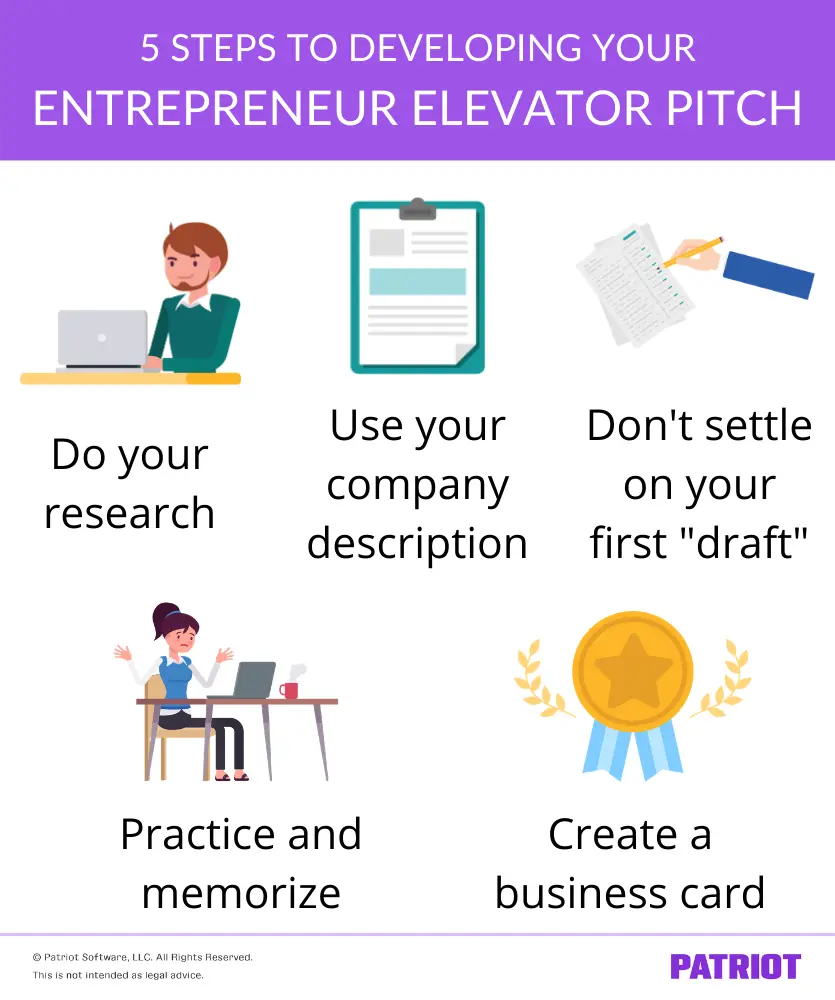Quick: Tell me what your business does in under a minute and a half. Can you do it? Probably not—for one of two reasons. First, we can’t hear you. And second, you may not have nailed down your entrepreneur elevator pitch yet.
Concisely articulating your business idea or business is hard. It takes significant practice, know-how, and tweaking. Read on to learn more about the elevator pitch in entrepreneurship.
What is an elevator pitch?
An entrepreneur elevator pitch is a short speech (generally less than a minute) detailing a business idea or existing business. The point of an elevator pitch in entrepreneurship is to hook investors in the time it takes to ride an elevator. Business owners use elevator pitches to market their company.
So, how much could you say in a typical elevator ride? Depending on what floor you’re going to, not much. That’s why it’s important to have a strong opening and dive right into the point in an elevator pitch.
If you’re riding an elevator with a potential investor, what would you need to say to get them interested in your business? What could you say that would make them want to learn more, and possibly invest, in your company?
Think of your elevator pitch as a (very) short company description for a business plan. Give a brief overview of what your business does, why it’s unique, and why it matters.
Keep it short and simple. An elevator pitch shouldn’t be a long-drawn-out spiel. Instead, it should be clear and concise and leave your audience wanting to contact you for more information.
Parts of an elevator pitch in entrepreneurship
Effectively, your elevator pitch is a marketing and sales pitch. Elevator pitches can differ, but there are some main parts they should all have in common.
An entrepreneur elevator pitch typically includes:
- Introduction: What is your name and your business’s name?
- Products or Services: What does your business do?
- Target Market: Who are your potential customers?
- Unique Value Proposition: How can you help your target market? How are you different from your competitors?
- Next Steps: Why are you giving someone your pitch? What action do you want them to take? (e.g., provide business card)
Developing your entrepreneur elevator pitch: 5 steps
Take a look at the following five tips to help you craft and deliver a successful entrepreneur elevator pitch.

1. Do your research
Don’t go blindly into your elevator pitch with nothing more than the knowledge of what your business offers or is going to offer. You need to be able to share information about your target customers and competitors.
And to do that, you need to do your research ahead of time. If you haven’t already, conduct a market analysis to learn more about your industry, competitors, and customers.
Find out about your industry’s current state and its projected growth. Is it a strong industry that’s growing? What kind of potential does your business have in the industry?
Next, move onto the customers your business is targeting. Who are they? Research details like their age, income, gender, location, and occupation. Determine how much they would be willing to pay for what your business is offering, how frequently they need your offerings, and how your offerings fill a need.
Your competitor research should analyze their strengths and weaknesses. What are they doing well at? Where are some opportunities they’ve missed? Analyzing your competitors can help you to find and articulate your business’s unique value proposition.
2. Use your company description
After you do your market analysis, you likely report your findings in your small business plan. There are a number of sections in your plan, including your company description.
An elevator pitch is a condensed version of a company description. So, let’s go over the parts of the description.
A company description should include your business name, goals, target customers, products or services, competitive advantages, mission statement, and business location and structure.
You won’t be able to cover all of that in a short, minute-long speech. But, you can use it as a baseline for coming up with your pitch. Shrink it down, prioritize the information in your description, and get to drafting your elevator pitch.
3. Don’t settle on your first “draft”
Flowery language is hard to avoid. And more often than not, it’s probably found its way into your first elevator pitch draft.
The best way to get your elevator pitch down to a concise speech is to make a few drafts. Write it out, read it out loud, and cut out any filler words.
Remove the things that don’t matter. Sure, some things might make you and your business look good, but does it belong in your initial pitch? Will it convince a potential investor to want to talk more? If not, cut it out.
Remember that your elevator pitch isn’t the only contact you’ll have with the person you’re talking to. It’s the first contact—the one that’s meant to reel them in. You can mention things you’ve cut from your first draft at a later time.
4. Practice and memorize
Practice makes perfect. If you don’t practice your elevator pitch before delivering it to a potential investor, you may get tripped up or ramble.
Once you’ve settled on your final elevator pitch, practice it out loud. Work on your inflection and ability to engage your audience. Time yourself. Eventually, with enough practice, memorizing your elevator pitch will become easy. And when you have your pitch down pat, you can focus on channeling your passion into it.
Practice on your family or friends and get their thoughts. Again, time yourself. Your speech duration might be different between when you’re talking aloud to yourself and when you’re actually speaking to people.
5. Create a business card
Elevator pitches should end with an overview of the next steps. Most culminate with the speaker giving their entrepreneur business card to the person or people they’re talking with.
So, if you want your audience to be able to contact you post-pitch, you need to first create some business cards—and remember to carry them around.
Your business card should have your name and position, as well as your company name. Don’t forget to include pertinent information like your business website, phone number, and email address.
Once you talk in-depth with potential investors about your business, you need the records to back up your claims. That’s where your accounting books come in. Manage your books with Patriot’s accounting software. Start your free trial now!
This is not intended as legal advice; for more information, please click here.


